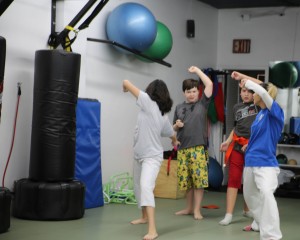Special Needs and Anti-Bullying: Part One
Self-esteem, self-respect, and self-worth are important areas of development as we grow. They are also areas in which we’ve all experienced difficulty at some point in our lives. Just think of your junior-high years, and you’ll likely recognize what I mean.
Many children with special needs, however, struggle with these areas on a regular basis, not just during a few gangly pre-teen years.
Add in bullying, which occurs far more often than we usually realize, and special-needs kids and adults can end up with terrible, life-long struggles in these areas. We want to highlight the importance of anti-bullying in this two-part series because recognizing bullying behaviors and having tools to deal with those behaviors is vital for teachers, coaches, parents, friends, siblings, and special needs individuals.
What Is Bullying?
An important first step in dealing with bullying is clearly defining what bullying is, as well as what it is not. According to www.StopBullying.gov, “Bullying is unwanted, aggressive behavior among school aged children. It involves a real or perceived power imbalance and the behavior is repeated, or has the potential to be repeated, over time.” Let’s unpack that definition. First, bullying is connected with a behavior, not with a person. When discussing bullying with your special-needs child or with another adult, recognize that an individual is displaying a certain behavior but is not defined solely by that behavior (i.e., don’t refer to him/her as “the bully”). Next, the behavior is unwanted and aggressive. Conflict or disagreement between two individuals is not bullying. Conflict can become bullying when a power imbalance occurs, as when one child begins to display dominant behavior over another through name-calling, verbal or written threats, exerting physical force, and the like. He or she may think that the target is weaker (physically, mentally, or emotionally) than himself/herself. When such harassment becomes repeated behavior, or if the power imbalance is not recognized and addressed promptly to prevent it becoming repetitious, we end up with bullying situations.
One further note: bullying in school settings, including events sponsored by schools, can be more than just a problem behavior–it can become an illegal activity called “disability harassment.” Disability harassment is defined by the U.S. Department of Education (2000) as “intimidation or abusive behavior toward a student based on disability that creates a hostile environment by interfering with or denying a student’s participation in or receipt of benefits, services, or opportunities in the institution’s program.” If you are aware of such a bullying situation in school settings, contact the school administrators immediately so that they can take proper measures.
Emotional, Physical, and Mental Results of Bullying
A natural result of being bullied is that the individual experiences sadness, frustration, and anxiety. Several other common results of bullying include depression, fear/apprehension, physical complaints (such as headaches, stomach/digestive issues, and fatigue), decreasing grades and academic struggles, and suicidal thoughts. Many children experience a combination of these emotions and struggles. Bullying that involves physical force can obviously cause bodily harm as well: bruising, swelling, cuts, etc. If you are around a child who displays one or more of these emotional, physical, or mental distresses, it’s a good idea to keep an alert eye and try to open the conversation to see if bullying may be involved.
A potential response to bullying that we can easily overlook is that the child who is on the receiving end of bullying may react strongly in an effort to feel powerful or in control, turning to bullying behaviors himself. He may not know how to approach an adult for assistance (or may be fearful of doing so). He also may have become so used to bullying behaviors taking place around him, as well as to him, that he instinctively turns to those behaviors when interacting with others. This is partly why it’s important to refer to bullying behavior instead of labeling a person as a bully. Those we view as “bullies” may well be lashing out in a nonverbal cry for help because they have been bullied in some way and don’t know how to deal with it.
Why Special-Needs Individuals Are at a Higher Risk
Many organizations have published statistics about the higher risk of bullying of special-needs individuals. Pacer.org states that “children with disabilities are two to three times more likely to be bullied than their nondisabled peers.” We know that bullying usually targets those who are different in some way. Children who have speech impediments, physical limitations, social skill challenges, mental limitations, or require physical assistance (such as a wheelchair or an oxygen tank) are much more vulnerable to harassment and bullying. Special needs individuals’ differences are part of what make these individuals beautiful and unique in their own way. Oftentimes children who are around special-needs kids have not been taught that differences are a good thing, and they have not received guidance in learning how to play with, interact with, and be friends with their special-needs peers.
At Be The Best Sport, we recognize that we all have differences. We are committed to providing safe, supportive, respectful, and fun environments for kids with special needs to thrive. Bullying is a big deal, and in part two we will address specific ways to help our kids know appropriate measures when bullying occurs. Check our schedule to learn more about the Fitness/Kickboxing/Anti-Bullying and Karate programs we are offering right now; it is designed to increase confidence and self-esteem, and they provide specific tools to deal with bullying behaviors.
Sources:
http://www.pacer.org/bullying/resources/students-with-disabilities/
https://www.stopbullying.gov/at-risk/groups/special-needs/BullyingTipSheet.pdf
http://www.ldonline.org/article/20001/
https://blog.ed.gov/2013/08/keeping-students-with-disabilities-safe-from-bullying/
http://www.bbc.com/news/education-27902500




